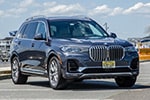It’s no secret that the autonomous car is the next big thing in the automotive industry. Most recently, the electric vehicle was the big thing, with each and every automaker scrambling to make electric cars. That’s easy now. Almost every single automaker has at least one electric or hybrid car in its fleet. Now, the next big thing is autonomy, getting these cars to drive themselves. The problem is that it’s very, very expensive to make it happen. Automakers are now looking at this cost and realizing that it may not be worth the investment.
“Although it is a substantial market, it may not be worth the scale of investments currently being sunk into it,”said an unnamed board member of an unnamed German automaker, due to confidentiality. Companies are investing billions of dollars into autonomous tech and automakers won’t see a good return on that investment for ages. When car companies started making electric cars, they knew they’d lose money at first. However, it turned around for the electric car and car companies don’t really see autonomy turning around.

So automakers are looking to partner up so they can share the brunt of the costly impact. BMW most recently did it, by partnering with Intel and Mobileye. The idea is to help create a single platform of autonomous software, rather than having a bunch of different ones. “Sitting at other companies, one rattles off the technological challenges and safety aspects, and you come to realize that many of us are swimming in the same sludge,” Klaus Buettner, BMW’s vice president autonomous driving projects, told Reuters. “Everybody is investing billions. Our view was that it makes sense to club together to develop some core systems as a platform.”
But it’s not just automakers who feel this way. “It’s impossible for me to believe there will be 50 successful autonomous vehicle software producers,” said John Hoffecker, global vice chairman of Michigan-based consulting firm AlixPartners.
Even governments are looking for automakers to team up and create a sort of industry standard software platform for autonomous cars to use. It’s much like the autopilot systems used for airliners. Airlines share the software base so that they can work together to create a safer technology with a consistent set of guidelines.

In 2016, the U.S. Department of Transport and the National Highway Transportation Safety Administration asked automakers to disclose their programming for when their cars face certain choices. For instance, if the car has to break the speed limit to avoid an accident, does it break the speed limit or allow the accident? “It is important to consider whether highly automated vehicles are required to apply particular decision rules in instances of conflicts between safety, mobility, and legality objectives,” said the U.S. DOT. “Algorithms for resolving these conflict situations should be developed transparently using input from federal and state regulators, drivers and passengers.”
This would go a long way to help create Robotaxis as well, which would be on-demand autonomous taxis (cue Mercedes-Benz E-Class jokes). Common autonomous infrastructure would be needed for such things to exist.
So rather than BMW working on its own system with Tesla on its own and Mercedes-Benz doing its own thing, it’s better if there’s a sort of universal platform that they can all work off of. Still, different companies are merging together to make their own software, which will likely have to comply with certain regulations and have its programming be transparent to government agencies and maybe even other automotive companies. It’s the only way to make creating an autonomous future safe, cost effective and efficient.
[Source: Rueters]





































































